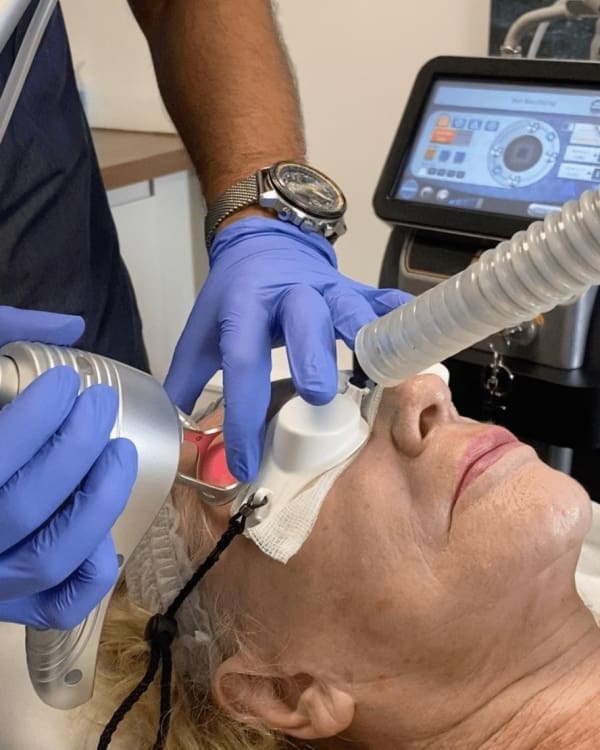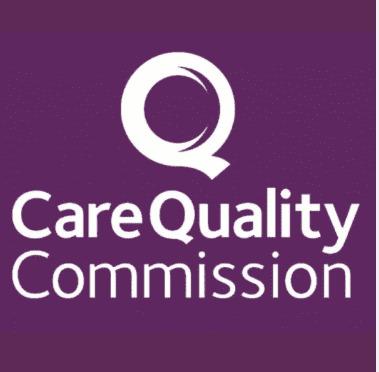Everything You Need to Know About Laser Treatments for the Face
Laser treatments for the face are a popular cosmetic procedure that can address a variety of skin concerns and promote skin rejuvenation. From acne scars to wrinkles, laser skin resurfacing treatments have become a go-to solution for people looking to rejuvenate their skin. This article breaks down how laser treatments work, the different types of lasers available, and what you can expect during the healing process.
What Are Laser Treatments for the Face?
Laser treatments use advanced laser technologies to target specific skin concerns such as wrinkles, acne scars, sun damage, and uneven skin tone. These treatments can help with collagen production, promoting skin firmness and smoother skin. The lasers work by sending short pulsed light energy or continuous light beams to remove the outer layers of damaged skin, allowing new skin to grow in its place.
Frequently used laser treatments include UltraClear, iPixel Resurfacing, and more.
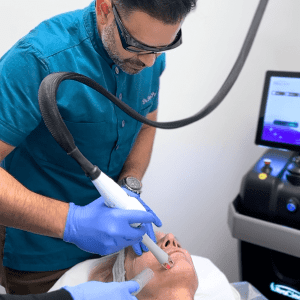
Common Types of Laser Resurfacing Treatments
There are several types of laser resurfacing treatments, each designed to treat different skin concerns.
1. Ablative Lasers: These are more aggressive lasers, such as the carbon dioxide (CO2) laser and erbium laser resurfacing. Ablative lasers remove thin layers of skin, making them effective for deep wrinkles, age spots, and acne scarring. Since they vaporize damaged skin, the healing process may take longer compared to non-ablative lasers, but the results are often more dramatic.
2. Fractional Lasers: Fractional lasers, like the Fraxel laser, treat only a fraction of the skin at a time, leaving the surrounding tissue intact. This approach helps the skin heal faster, reducing recovery time and minimizing discomfort. Fractional lasers are excellent for treating shallow scars, fine lines, and sun damage.
3. Non-Ablative Lasers: Non-ablative lasers, such as intense pulsed light (IPL), don’t remove layers of skin. Instead, they work beneath the skin’s surface to stimulate collagen growth. These are ideal for people looking for a less invasive option to treat wrinkles, enlarged pores, or sagging skin.
Benefits of Laser Resurfacing Treatments
Laser resurfacing treatments can help treat a wide variety of skin concerns, including:
– Acne scars and active acne
– Deep wrinkles and fine lines
– Uneven skin tone caused by too much sun exposure or hyperpigmentation
– Sun damaged skin, such as age spots and dark spots
– Stretch marks and enlarged pores
What to Expect During the Procedure
Laser treatments for the face are typically an outpatient procedure, meaning you can go home the same day. Your treatment plan will depend on your skin type, medical history, and the skin concerns you’re addressing. The procedure is usually customized for each patient to ensure the best results.
During the treatment, the laser beam will target the treatment area with either short pulsed light energy or continuous light beams. You might experience minimal discomfort, but your skin care specialist will ensure you’re comfortable by using a wrapped ice pack or numbing cream.
After the procedure, your skin will need time to heal. The treated area may appear red or swollen, but this is a normal part of the healing process. As your skin heals, new skin cells will form, and you will notice smoother, tighter, and more even-toned skin.
Laser Treatments for Darker Skin Types
If you have brown skin, very dark skin, or dark skin, it’s crucial to consult a specialist who has experience with laser treatments for these skin tones. Certain laser beams may cause pigmentation changes or damage to melanin-rich skin. Non-ablative lasers and fractional lasers are often safer for darker skin tones, as they cause minimal heat damage to the surrounding tissue. Your treatment plan should be completely tailored to your specific needs to avoid complications like bacterial infections or uneven pigmentation.
Post-Treatment Care
After your laser treatment, proper skin care is vital to ensure a smooth recovery. Follow your provider’s instructions carefully, which may include:
– Keeping the treated skin moisturized
– Applying sun protection factor (SPF) to prevent further sun damage
– Using a wrapped ice pack to reduce swelling
– Avoiding too much sun exposure until the skin heals
The recovery time can vary depending on the intensity of the laser used. Ablative lasers typically require longer healing times but offer more noticeable results. Non-ablative treatments, on the other hand, have a shorter recovery time but may require multiple sessions.
Risks and Side Effects of Laser Treatments
While laser treatments are generally safe, it’s important to be aware of potential risks and side effects. Common side effects include redness and swelling, which are usually mild and temporary. Some individuals may experience bruising, particularly those with fair skin. As with any invasive procedure, there’s a small risk of infection, so it’s crucial to follow post-treatment care instructions carefully.
Scarring is another potential risk, especially if the treated skin isn’t properly cared for during the healing process. Changes in skin pigmentation, such as darkening or lightening, can also occur, particularly in individuals with darker skin tones. Additionally, laser treatments can pose a risk to the eyes, including cataracts, retinal damage, and eye irritation, so protective measures are essential.
Discussing these potential risks with a qualified practitioner before undergoing laser treatments is vital. They can provide personalized advice and help you weigh the benefits against the risks to make an informed decision.
Choosing a Practitioner for Laser Resurfacing
Selecting the right practitioner for your laser resurfacing treatment is crucial for achieving safe and effective results. Here are some tips to help you make an informed choice:
- Experience Matters: Look for a practitioner with extensive experience in laser resurfacing treatments. An experienced professional will have a deep understanding of the technology and how to tailor treatments to individual skin concerns.
- Check Qualifications: Ensure the practitioner is qualified and certified to perform laser resurfacing treatments. This includes verifying their medical credentials and any specialized training in laser procedures.
- Read Reviews and Testimonials: Patient reviews and testimonials can provide valuable insights into the practitioner’s reputation and level of care. Look for feedback on their professionalism, results, and patient satisfaction.
- Research the Clinic: The clinic’s reputation is equally important. Ensure it is a reputable and safe environment for treatment, with up-to-date equipment and a clean, professional setting.
- Ask Questions: Don’t hesitate to ask the practitioner questions about the treatment. Inquire about the type of laser used, the expected results, and the potential risks and side effects. A good practitioner will be transparent and willing to address all your concerns.
By taking these steps, you can find a qualified practitioner who will provide the best possible care and results for your laser resurfacing treatment.
Cost and Pricing of Laser Treatments
The cost of laser treatments can vary widely based on several factors, including the type of treatment, the location, and the practitioner’s qualifications. Here’s a general idea of what you can expect:
- Laser Hair Removal: Typically ranges from £100 to £500 per session, depending on the area being treated.
- Laser Skin Resurfacing: Costs can range from £500 to £2,000 per session, depending on the extent of the treatment and the type of laser used.
- Laser Facial Rejuvenation: Generally costs between £200 and £1,000 per session, depending on the specific concerns being addressed.
- Laser Tattoo Removal: Prices usually range from £100 to £500 per session, depending on the size and complexity of the tattoo.
It’s essential to discuss the cost and pricing with a qualified practitioner before undergoing laser treatments. They can provide a detailed breakdown of the costs involved and help you understand the value of the treatment in relation to your specific skin concerns.
Who Should Consider Laser Skin Resurfacing?
Laser skin resurfacing is ideal for those looking to improve the appearance of their skin without undergoing cosmetic surgery. Whether you want to reduce deep wrinkles, treat acne scars, or improve skin firmness, laser treatments offer a highly effective solution.
Before scheduling a treatment, it’s important to have an initial consultation with a dermatologist or cosmetic surgeon to assess your skin type and medical history. This will help determine which laser resurfacing treatment is best suited for your skin concerns and ensure that your skin heals properly with minimal risks.
Frequently Asked Questions About Laser Treatments
Here are some frequently asked questions about laser treatments:
What is laser treatment?
Laser treatment is a non-invasive medical procedure that uses high-intensity light to target specific skin concerns, such as wrinkles, acne scars, and hyperpigmentation.
What are the benefits of laser treatments?
Laser treatments can improve the appearance of the skin, reduce fine lines and wrinkles, and address various skin concerns, including acne scars and uneven skin tone.
Are laser treatments painful?
While laser treatments can cause some discomfort, most people find it tolerable. Topical anesthetics can be used to minimize any discomfort during the procedure.
How long do laser treatments take?
The duration of laser treatments can vary from 15 minutes to several hours, depending on the type of treatment and the area being treated.
How many sessions are needed?
The number of sessions required can vary based on the type of treatment and the individual’s skin concerns. On average, 2-6 sessions are needed for optimal results.
Before and After Results of Laser Skin Resurfacing
Laser skin resurfacing can yield remarkable improvements in the appearance of your skin. Here are some typical before and after scenarios:
- Before: Fine lines, wrinkles, and uneven skin tone After: Smoother, brighter, and more even-toned skin
- Before: Acne scars and hyperpigmentation After: Reduced appearance of acne scars and hyperpigmentation
- Before: Dull and tired-looking skin After: Glowing and rejuvenated skin
It’s important to note that individual results can vary, and having realistic expectations is crucial. Consulting with a qualified practitioner can help you understand what results you can expect based on your specific skin concerns and treatment plan.
Conclusion
Laser treatments for the face provide a fantastic way to rejuvenate your skin and address various skin concerns. Whether you’re dealing with acne scarring, sun damage, or deep wrinkles, there’s a laser resurfacing treatment that can help. The use of advanced laser technologies has made these procedures safer, quicker, and more effective, offering smoother, younger-looking skin with minimal discomfort and downtime.
Be sure to consult with an experienced professional to determine the right treatment plan for your skin type, and always take care of your treated area to ensure the best results!








